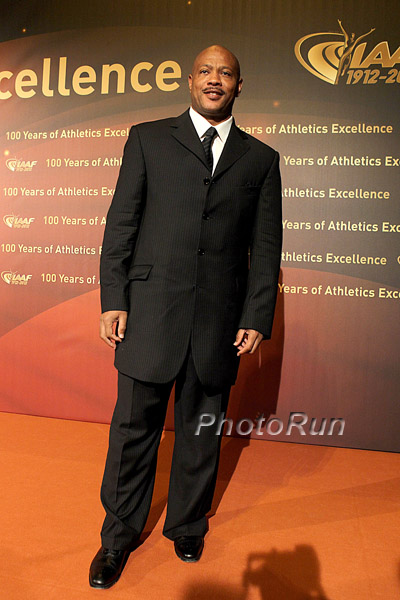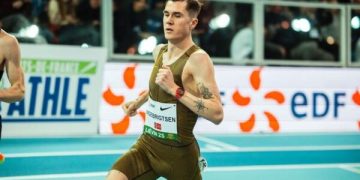I have to admit, Mo Greene has always been one of my favorite athletes. In his day, Mo Greene was showman, great sprinter and hugely talented and focused athlete. Now, Mo Greene is media mogul, track coach and Olympic champion.
Going With The Mo
Decorated Sprint Great Maurice Greene Does It His Way
September 1, 2013
Usain Bolt isn’t the only sprinter who has dominated his era. Remember Maurice Greene? As the 20th century was winding down and the 21st century was dawning, there was no sprinter on the planet who was more feared, more successful, or more decorated than Big Mo. During  a career which spanned a decade, Greene collected a substantial amount of championship hardware: 4 Olympic medals, including 2 golds [100m and 4×100] from Sydney ’00; and 5 golds in world championship competition, including Bolt Slam golds [100m, 200m, and 4×100] in Seville ’99. The former world record holder at 100m [9.79], Greene still holds the indoor WR’s for 50m [5.56] and 60m [6.39]. No doubt about it. When the chips were on the table, it was a safe bet that Maurice Greene would come up big.
a career which spanned a decade, Greene collected a substantial amount of championship hardware: 4 Olympic medals, including 2 golds [100m and 4×100] from Sydney ’00; and 5 golds in world championship competition, including Bolt Slam golds [100m, 200m, and 4×100] in Seville ’99. The former world record holder at 100m [9.79], Greene still holds the indoor WR’s for 50m [5.56] and 60m [6.39]. No doubt about it. When the chips were on the table, it was a safe bet that Maurice Greene would come up big.
Some years ago – and as is the case with all track & field performers – Maurice Greene had to face and deal with the approaching twilight of his career as an elite, world-class athlete. For many, this can be a time of quiet trauma. But – from all appearances – it would appear that Maurice Greene is facing and handling this inevitable life change with the poise and light-hearted good nature that marked his illustrious sprinting career, thank you very much.
In the afterglow of the 14th IAAF World Outdoor Track & Field championships, Maurice Greene was happy to spend some time offering insight on his current activities and his future plans.
“I’ve been working with Eurosport for the last two years – doing commentating and things like that,” explains the sprint legend as he outlines his recent activities. “The producers came to me and we kinda developed this show together.” The emerging show – Greene Light – has been crafted to provide more in-depth insights into elite athletes and their real lives – athletes such as like Allyson Felix and Blanka Vlasic – than could be garnered from programs focused exclusively upon athletic performance. “I told them earlier that I would rather make the people really get your motor up, rather than just reporting the same thing over and over. So it started that I would go around the country – wherever the athlete is – and visit them. They would show me around and tell me the things they do off the track. And then we get into a little bit of the track stuff.” And with a smile he adds, “Here at the world championships, I’m just talking with athletes going over what happened during the day.” Could a program like Greene Light work in the United States to provide much-needed increased television exposure to track & field? “I don’t know,” Greene confesses. “But we need to figure out a way.”
As a world class athlete, Maurice Greene was never shy about voicing his opinion on a whole array of topics. And as he has made the transition from elite sprinter to one of the elder statesmen of the sport, none of that has changed. When asked how he responds to Ato Boldon’s theory that a better understanding of race technique – not superior athleticism – is the primary reason for faster sprinting times, the former 100m WR holder doesn’t hesitate. “I agree with him [Boldon]. I would say our generation really started it. I come from the school of race pattern technique – it’s what makes you run fast. There are two types of runners: anybody can run; but not everybody can race.”
Greene explains how he and revered sprint coach John Smith were able to develop a winning formula for consistent sprinting success. “I always say a man without a plan is going nowhere. But if you have a man with a plan and if he follows that plan, he can accomplish anything. So our plan was to break it down bio-mechanically and we studied every aspect. And that’s how we determined how to run so fast all the time. That’s why we were so consistent. And now, today’s sprinters are just taking it a step further. And it is all coming from the technical aspect of it.”
But unlike their predecessors, have today’s sprinters learned that relaxation – not anger – is a critical component to better performance? “I just think they [the current generation of sprinters] are subtlety different. We are in a new generation now,” Greene offers. “How we used to prepare ourselves is not the same way they prepare themselves. Not everyone [today] is at the line smiling and waving and everything else. You may have a couple sprinters doing that, but a couple are stone-faced. It’s just everyone finding their own mode of getting ready to compete,” Reflecting upon his own pre-race preparation, Greene confides, “I wasn’t always mad at everybody. I was just intense. And that is just how I got ready to race.”
Greene’s light-hearted demeanor quickly becomes serious as the conversation turns toward training on the edge and the inevitability of injuries. “When you take that body to the limit, it’s hard. But that is what we train our bodies to do. We train our bodies to go to the limit,” says Greene in advancing his notion about the toll extracted by pinnacle performances. “And it’s just a fact once you stress your body like that, rest is needed. When somebody makes a big PR, you often then don’t see them for a while because their body has gone through something and it’s hard to re-focus.”
All of this causes the sprint legend to reflect upon Allyson Felix’s scary hamstring injury in the women’s 200 final. “All I know is that it is a slight tear. It’s not so serious, but every tear is serious,” Greene explains. He is hesitant to forecast the length of her road to recovery. “It all depends upon how her body heals,” he admits. “It could be two or three weeks if she does the right things. But it could be a nagging injury that lasts a month or month and a half. She started training really late this year because of the last two years that she had.” And with a forlorn look that suggests he feels Felix’s pain, Greene adds, “It’s just hurtful to see her go down like that.”
It is often difficult for sprint legends to look at current dash performers and offer an honest, unbiased evaluation. But Greene doesn’t hesitate in suggesting where Usain Bolt fits in the constellation of track & field’s greatest sprinters. “He has to be at the top,” the sprint legend states without equivocation. “In this sport – a sport that I’ve done – and I’ve done a lot of great things – you have to say Usain is at the top.” Explaining further, the former Olympic and world champion offers, “He has surpassed everything that anybody did before him. I don’t know a good argument why not to put him at the top.” Greene takes time to reflect upon the oft-pursued championship level sprint triple: victories in the 100m, the 200m, and the 4×100 relay. It is a championship hat trick Greene accomplished once – at the ’99 Seville world championships. Usain Bolt has captured these triple wins – the Bolt Slam – four times. But for an inattentive false start in Daegu, Bolt would have turned the trick five times. Asked to speculate how long Bolt’s unmatched championship record might last, Maurice Greene flashes that trademark smile and – with a laugh – blurts, “Until somebody comes down from Mars!”
Not yet 40, Maurice Greene has many productive years ahead. He is a man who knows and appreciates the benefit of a plan. So what’s ahead for the sprint icon who has formerly
undertaken such disparate assignments as handling ambassadorial duties for the IAAF and performing on Dancing With The Stars? “I work with a lot professional football players. I work with guys getting ready to play football,” notes Greene who also was recently named to the track & field coaching staff at UCLA. “And I work with kids also,” says the man who has received the USATF Humanitarian of the Year Award in recognition for his work with the Maurice Greene Finish the Race Youth Foundation he founded in his home town of Kansas City. “I’ll keep doing it.”
Some years ago, Greene provoked comments – and raised more than a few eyebrows – when he got a tattoo that read “G.O.A.T.” When asked then about its meaning, Greene explained that the ink abbreviation stood for “Greatest Of All Time.” It is undoubtedly true that Carl Lewis, Usain Bolt, and their followers may take issue with the sprinter’s controversial claim. But a fair assessment of Greene’s decorated career of sprint accomplishments – especially in light of his agile adaptation to new roles in the world of track & field – might nonetheless support the notion that Maurice Greene is becoming a “Grand Oracle About Track.”






















